AeroMomentum
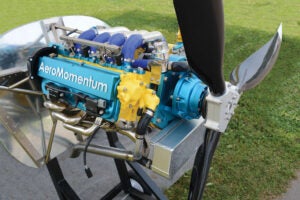
Mark Kettering at AeroMomentum reports no major changes in his engine lineup for 2021 except he finally had to raise prices. “It’s not just one thing: wages, shipping, materials—aluminum tubing has doubled, not that we use much of it—but all have risen.”
So, for 2022 AeroMomentum continues with 14 engines built around a 1000cc three-cylinder, 1300 and 1500 four-cylinders, and a turbocharged 2.0-liter four-cylinder that has proven especially popular. There have been some incremental improvements, mainly in wiring.
In large part there are many variations of the AeroMomentum engines because the 1.3- and 1.5-liter four bangers can each be had in upright or heavily canted form, plus each offers three states of tune. The upright or canted options are strictly for packaging ease in different airframes and make no difference in power output (but do in price). The power differences come from either stock engines or those with AeroMomentum’s more aggressive camshaft and head work, or ultimately the cam, head work and higher rpm.
AeroMomentum engines begin with brand-new automotive long blocks. Suzuki is the source of the 1300 and 1500 engines; the others are non-Suzuki and cannot be revealed as part of the sourcing agreement. All engines are built from all-new parts; no salvage or used engines are ever used. Power ranges from 75 to 260 hp, and Mark compares his engines to the O-200 and big-bore Continentals along with 235–540 Lycomings.
All AeroMomentum conversions use a helical, spur-gear prop reduction gearbox. It features custom 8620 alloy gears (not quick-change auto racing gears) and like many of AeroMomentum’s other parts, it is designed in-house but forged, machined, heat-treated and otherwise produced by out-of-house vendors. It is then assembled in-house at AeroMomentum. The highest-time gearbox so far logged 5500 hours in an airboat with no issues. AeroMomentum also offers various firewall-forward supporting parts such as engine mounts and cowlings, plus their own Aero-Graph engine monitor.
Kettering also commented on the increasing trend toward do-it-for-me customers and plug-and-play components. “Our wiring harness is as plug and play as we can make it. The circuit breakers have everything attached to the engine already plugged in…just connect the power and ground. Our Aero-Graph engine instrument has just one wire to connect by the customer. It’s preprogrammed, calibrated, ready to go. We didn’t think many would buy it; we thought people would rely on their glass panels, but many are buying it just because of the plug-and-play.”
ADEPT Airmotive
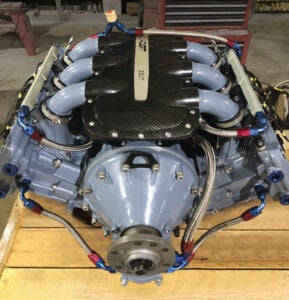
After playing possum for years, South Africa-based ADEPT has hired Texas-based Lee Brinley as their North American front man and are poised to raise their profile and sales in 2022 after “good progress” in 2021.
ADEPT is still in its early days and playing for the higher, faster, expensive end of the market with a nearly flat, all-new, 3.2-liter 120˚ V-6 featuring the expected FADEC engine control. More unexpectedly, it sports a knock sensor, allowing nearly any fuel from 100LL to mogas laced with ethanol or methanol. Power is rated at a base 260 hp, then ranging through several steps to 360 hp in turbocharged form. Future engines are being developed according to ADEPT; they will offer more than 360 hp.
All versions of the new engine are liquid cooled, boast dry sump oiling with piston squirters, billet crankshafts and connecting rods, forged pistons, plus share the same bore and stroke. The differences are in the camshafts, injectors, computer mapping and other tuning factors. All turbo engines use a single turbo.
ADEPT, who we’re rating as in the late prototyping stage, has already delivered a handful of engines in the U.S. to well-heeled, early adopting, fast-glass aircraft customers hoping to fly their engines by mid-2022. ADEPT’s prototype has been flying for some time, and they are continuing to take orders for more. In that process ADEPT starts with a quote and takes a small, refundable escrow deposit, followed by a larger production deposit with a promise to deliver the engine within 100 days. The company is also looking for investor income as well, as they wish to substantially increase their presence.
Advantages to the ADEPT engine center around increased efficiency (less weight, more power), lack of shock cooling and other liquid-cooling advantages. Smoothness, along with the already demonstrated capability to pass possible future emission regulations with an optional catalytic converter—now there’s a general aviation first—are also cited. The engine is also a foot narrower than a 550 Continental, so reduced frontal area is another plus for those making a new cowling. Look for ADEPT in their own booth at AirVenture 2022.
Auto PSRU’s
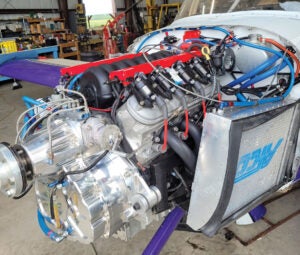
Auto PSRU’s had the standout advice of the continuing COVID era: “Don’t buy anything right now” because pricing was silly due to overwhelming supply issues. Citing steel prices gone 500% higher, Auto PSRU’s said their cost to build one of their many PSRUs was more than the retail price.
Such price spikes have a way of retracting about as fast as they rise, so if you’re looking for an auto conversion in 2022 it’s definitely worth calling. We’re sure Auto PSRU’s wouldn’t mind making a sale. Naturally, there will be a delay as Auto PSRU’s reports a six-month wait to get Chevy crate engines.
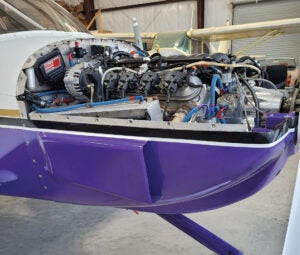
High material prices and slow delivery or not, Auto PSRU’s continues to massage their spur-gear gearboxes. Interest is highest in their Chevy V-8 and gearbox combination, much of that from the RV-10 crowd and Auto PSRU’s has thus purchased an RV-10 as a test bed. Their Chevy firewall-forward package was originally built around LS-1 engines, but they’ve moved to the outwardly nearly identical LS-3 as that’s what’s available plus it gives another 20 hp. Their preference is actually used engines because new LS-3s uses Siamese cylinders and one less head bolt.
Auto PSRU’s traditional engine and gearbox combinations for Subaru and Mazda 13B fitments remain available though demand is slow. The Subaru engines, especially, are becoming difficult to find; the Japanese engine has been out of production for some time, so Auto PSRU’s needs to locate a good, rebuildable core and keep an eye on their engine specialists to ensure they deliver a quality build. Wankels are less troublesome as they source their core rotary engines from noted builder Atkins Rotary/American Rotary in Oregon.
All said, “We handle from about 150 to 550 horsepower,” says Stuart Davis of Auto PSRU’s. All their gearboxes feature self-contained, pressurized oiling and the ability to accommodate constant-speed propellers. With custom gear ratios and adapters they’ll work with almost any engine, and Auto PSRU’s significant custom fabrication ability is a boon to builders venturing off the beaten path.
Viking Aircraft Engines
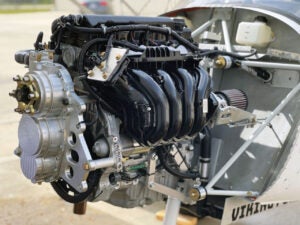
Viking specializes in late-model Japanese auto conversions, giving them the latest modern engine design features such as direct injection and tight assembly tolerances. Their three-engine lineup is based on current, multi-valve, liquid-cooled, computer-controlled engines from Honda and Mitsubishi that were built on state-of-the-art automotive production lines. Furthermore, backed by automotive production levels, Viking prides themselves in keeping a large enough inventory to offer next-day shipping (when possible these days) of their several firewall-forward kits.
Viking starts with low-mileage used engines with “full background and tracking” to keep costs low and inventory up. TBO is given at 2000 hours, and replacement engines are understandably low cost.
For 2022 Viking has dropped the 170-hp Honda Civic conversion saying its 195-hp Accord-based replacement gives more power for essentially no weight increase. They’ve also been putting time on their DUC constant-speed propeller. The carbon fiber prop weighs only 14 pounds and uses a clever pushrod actuator so the electrics are solid mounted in the engine compartment; they’ve got 400 hours on one of these without issues.
The biggest news from Viking though is the release of a 150-hp engine based on the Honda HRV 1.8 liter. It’s been fitted to Zenith and Murphy Rebel airframes, plus a Cozy.
Viking’s entry-level offering is a 90-hp version of a three-cylinder, DOHC, 12-valve Mitsubishi engine. Fitted with Viking’s own gearbox (climb or cruise gear ratios can be ordered; it can also work in pusher applications), the combination weighs but 159 pounds and posts a particularly muscular low-end torque curve when augmented with the lower of the two gear sets. This engine is aimed particularly at the Zenith CH-701.
For its best-selling 130-hp engine Viking starts with the direct-injected Honda Fit four-cylinder powerplant. Geared with a fairly steep 2.33:1 ratio, and also with unexpectedly good low- and midrange thrust, the combination weighs 220 pounds. Because the Fit engine has its exhaust manifold integral with the cylinder head, the engine is not a good candidate for turbocharging, but the gasoline direct fuel injection (fuel is shot directly into the cylinders) gives in-cylinder cooling allowing a high 10.8:1 compression ratio for increased efficiency. By venting crankcase blowby to the atmosphere, Viking escapes the valve deposit issues found in automotive GDI applications.
Viking’s top offering is the 195-hp version of the turbocharged Honda Accord engine. Naturally, this also gives a fat low-end torque curve (there’s nearly 440 pound feet of torque at the prop at only 1250 rpm). This engine is also augmented by Viking’s gearbox and Honda’s gasoline direct injection. Weight naturally rises to 260 pounds but either 100LL or mogas can still be run. As with other modern, small-displacement, liquid-cooled engines, Viking specifies lead-scavenging additives with these engines if run on 100LL avgas.
Multiple firewall-forward kits and supporting parts are available from Viking to support these engines in Zenith, RANS, Van’s, Kitfox, GlaStar and other airframes. Viking notes they have engines in the field with over 1300 total hours. Another perk is engine installation services if you can bring your project to their Edgewater, Florida, facility.
| Manufacturer/Model | Drive | Horsepower | Weight | Price |
|---|---|---|---|---|
| 260N V-6 | geared | 260 hp @ 5500 rpm, normally aspirated | 306 lb w/ radiator, alt, EFI, starter, dry sump system | $60,000 |
| 280N V-6 | geared | 280 hp @ 5500 rpm, normally aspirated | 306 lb w/ radiator, alt, EFI, starter, dry sump system | $65,000 |
| 300N V-6 | geared | 300 hp @ 5500 rpm, normally aspirated | 306 lb w/ radiator, alt, EFI, starter, dry sump system | $70,000 |
| 320T V-6 | geared | 320 hp @ 5500 rpm, turbocharged | 340 lb w/ radiator, alt, EFI, starter, dry sump system | $85,000 |
| 360T V-6 | geared | 360 hp @ 5500 rpm, turbocharged | 340 lb w/ radiator, alt, EFI, starter, dry sump system | $90,000 |
| AeroMomentum | ||||
| AM10 | geared | 85 hp @ 6000 rpm – upright | 139 lb w/ PSRU, starter, alternator, ECU | $9995 (production hold) |
| AM13 standard | geared | 100 hp @ 5800 rpm – upright | 170 lb w/ PSRU, starter, alternator, ECU | $9,995 |
| AM13 standard | geared | 100 hp @ 5800 rpm – low profile | 170 lb w/ PSRU, starter, alternator, ECU | $11,495 |
| AM13 camshaft, head porting | geared | 112 hp @ 5800 rpm – upright | 170 lb w/ PSRU, starter, alternator, ECU | $13,995 |
| AM13 camshaft, head porting | geared | 112 hp @ 5800 rpm – low profile | 170 lb w/ PSRU, starter, alternator, ECU | $15,495 |
| AM13 camshaft, head porting, high rpm | geared | 126 hp @ 6500 rpm – upright | 170 lb w/ PSRU, starter, alternator, ECU | $15,495 |
| AM13 camshaft, head porting, high rpm | geared | 126 hp @ 6500 rpm – low profile | 170 lb w/ PSRU, starter, alternator, ECU | $15,495 |
| AM15 standard | geared | 117 hp @ 5800 rpm – upright | 185 lb w/ PSRU, starter, alternator, ECU | $11,995 |
| AM15 standard | geared | 117 hp @ 5800 rpm – low profile | 185 lb w/ PSRU, starter, alternator, ECU | $13,495 |
| AM15 camshaft, head porting | geared | 131 hp @ 5800 rpm – upright | 185 lb w/ PSRU, starter, alternator, ECU | $15,995 |
| AM15 camshaft, head porting | geared | 131 hp @ 5800 rpm – low profile | 185 lb w/ PSRU, starter, alternator, ECU | $17,495 |
| AM15 camshaft, head porting, high rpm | geared | 147 hp @ 6500 rpm – upright | 185 lb w/ PSRU, starter, alternator, ECU | $15,995 |
| AM15 camshaft, head porting, high rpm | geared | 147 hp @ 6500 rpm – low profile | 185 lb w/ PSRU, starter, alternator, ECU | $17,495 |
| AM20T | geared | 260 hp @ 6000 rpm – low profile | 285 lb w/ PSRU, starter, alternator, ECU, turbo | $19,995 |
| Auto PSRU’s | ||||
| LS-3 Chevrolet | geared | 360 hp @ 4500 rpm (centrifugal clutch) 1.666:1 ratio | 580 lb installed, typical, complete | $44,800 FF, est. call |
| 2.5L Subaru | geared | 150 hp @ 5000 rpm (centrifugal clutch) 1.859:1 ratio | 355 lb installed, typical, complete | $33,100 FF, est. call |
| 3.0L Subaru | geared | 230 hp @ 5000 rpm (centrifugal clutch) 1.859:1 ratio | 375 lb installed, typical, complete | $33,400 FF, est. call |
| Viking Aircraft Engines | ||||
| V-90 Mitsubishi | geared | 90 hp @ 5800 rpm | 160 lb w/ PSRU, exhaust, alternator | $9,995 |
| V-130 Honda Fit | geared | 130 hp @ 5400 rpm | 215 lb w/ PSRU, exhaust, alternator | $11,995 |
| V-150 Honda HRV | geared | 150 hp @ 5800 rpm | 239 lb w/ PSRU, exhaust, alternator, starter, ECU | $15,500 |
| V-195 Turbo Honda Accord | geared | 195 hp @ 5400 rpm | 260 lb w/ PSRU, exhaust, alternator, starter, ECU | $18,500 |













